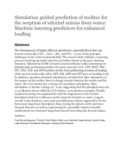Please use this identifier to cite or link to this item:
http://ir-library.mmust.ac.ke:8080/xmlui/handle/123456789/2064Full metadata record
| DC Field | Value | Language |
|---|---|---|
| dc.contributor.author | Wanyonyi, Fred Sifuna | - |
| dc.contributor.author | Fidelis, Timothy Tizhe | - |
| dc.contributor.author | Louis, Hitler | - |
| dc.contributor.author | Mutua, Gershom Kyalo | - |
| dc.contributor.author | Orata, Francis | - |
| dc.contributor.author | Rhyman, Lydia | - |
| dc.contributor.author | Ramasami, Ponnadurai | - |
| dc.contributor.author | Pembere, Anthony M.S. | - |
| dc.date.accessioned | 2022-09-19T11:30:32Z | - |
| dc.date.available | 2022-09-19T11:30:32Z | - |
| dc.date.issued | 2022-06-01 | - |
| dc.identifier.uri | ttps://doi.org/10.1016/j.molliq.2022.118913 | - |
| dc.identifier.uri | https://www.sciencedirect.com/science/article/abs/pii/S0167732222004512 | - |
| dc.identifier.uri | http://ir-library.mmust.ac.ke:8080/xmlui/handle/123456789/2064 | - |
| dc.description.abstract | The development of highly efficient adsorbents, especially those that can harvest anions like CrO42−, AsO43−, NO3– and PO43−, is one of the principal challenges in the water treatment field. The current study utilized a screening process involving an initial selection of zeolites based on the pore-limiting diameter, followed by GCMC (Grand Canonical Monte Carlo) simulations to identify high-performing zeolites for anion removal. CLO, LTN, MWF, TSC, ITV, PAU, FAU and DFO zeolites are the best performing in terms of loading while several zeolites like ANA, DFT, BIK, SBN and JNT gave no loading at all. In addition, quantum chemical calculations revealed that after adsorption of the anions on the zeolite, there is charge transfer between the zeolite and the anion. The CLO cluster has a charge of 0.64 before adsorption. After adsorption, it attains a charge of −0.06, suggesting that the phosphate ion acts as an electron donor while the CLO cluster, as an electron acceptor. Finally, machine learning was employed to rank the importance of the various descriptors that have influence on the removal of anions in water. Largest overall cavity diameter, mass and accessible pore volume appeared to be the three most important descriptors, thus, tuning the sphere cavity and inter channel diameter as well as engineering the accessible volume of zeolite architectures are of utmost important toward harvesting the desired anions. | en_US |
| dc.language.iso | en | en_US |
| dc.publisher | Journal of Molecular Liquids | en_US |
| dc.subject | Simulation, guided, prediction, zeolites, sorption, selected anions, water,Machine learning, predictors, enhanced loading | en_US |
| dc.title | Simulation guided prediction of zeolites for the sorption of selected anions from water: Machine learning predictors for enhanced loading | en_US |
| dc.type | Article | en_US |
| Appears in Collections: | Gold Collection | |
Files in This Item:
| File | Description | Size | Format | |
|---|---|---|---|---|
| Simulation guided prediction of zeolites for the sorption of selected anions from water.pdf | 85.38 kB | Adobe PDF |  View/Open |
Items in DSpace are protected by copyright, with all rights reserved, unless otherwise indicated.
